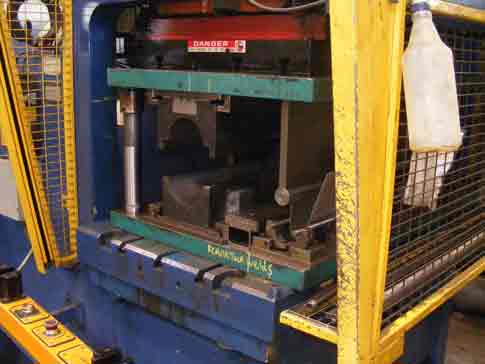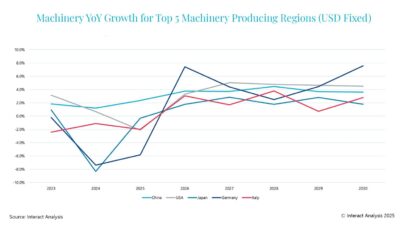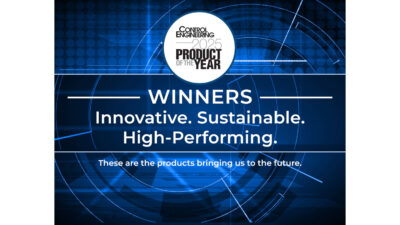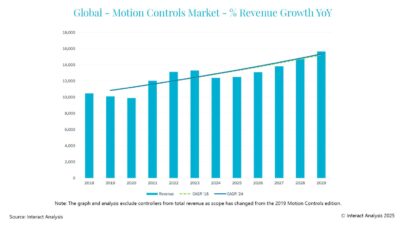Application Update: In less than one month, a rebuild automates press operations to increase production rates and improve quality.

In 2012, lightning struck Southern Manufacturing Group’s facilities, causing electrical damage to the automotive-component and industrial valve maker’s 175-ton hydraulic forming press and its automation system, in particular.
Purchasing a new hydraulic forming press would have been prohibitively expensive, in the range of hundreds of thousands of dollars. Therefore, SMG needed a company that could repair the forming press quickly to maintain its production schedule.
Repairing and improving the press
Despite its age, the robust 40-year-old machine was definitely worth repairing. As a dual-action press, it shapes two separate parts in different ways at the same time. During the first step, the hydraulic forming press bends the metal in half without creasing it. In the second, it rounds the metal piece. Functioning continuously, the process significantly increased production yield as compared to simpler machines that only shape one part at a time. Such complexity also required more than a simple automation system, as multiple operations needed to be controlled simultaneously to close tolerances.
To find an economical and timely solution, SMG turned to the fully licensed electrical and mechanical contractor American Construction Technologies (ACT), in Nashville, Tenn. When ACT inspected the press, its engineers were faced with multiple challenges, including the repair or replacement of the automation system. ACT called my company, KCC Software, in Huntsville, Ala., for an automation solution that would not only work with the existing machine, but also improve it. While ACT would build the new automation system enclosure and perform all wiring, as well as improving and updating parts of the hydraulic system, we would take on the challenge of quickly creating a new, modern automation system.
Designing the new automation system
Presses designed just 10 years ago often don’t have the automated features and functionalities that help manufacturers decrease cycle times and improve production consistency. For example, SMG’s old automation system couldn’t automate press runs, so operators needed to manually enter instructions with each job setup. Not only did this add to cycle times, it also significantly increased the possibility of error and inconsistent part runs. Generally, the old automation system was becoming difficult to support.
Because the old automation system was clunky and could be replaced without replacing the entire press, SMG considered a new system, requiring that quick design and installation at a reasonable cost. After preliminary investigations, KCC discovered it was able to satisfy SMG’s requirements.
KCC began design of the automation system by considering the system requirement—pressure transducer feedback, encoder feedback, fast response times, accurate and timely valve controls —indicating that a very flexible controller was needed.
A new programmable logic controller (PLC) CPU module and high-speed counter module was used to interface to the encoder on the press. Standard I/O cards were used for the discrete inputs and relay outputs that the press required and an analog input card for pressure transducer feedback.
After installing these components, a key next step was programming the force of the hydraulic press to match the preset movements of the machine. We stored the correct pressure, the corresponding ram travel, and other key parameters in the new controller’s memory by job number. The die setter configured them as automatic presets. For deep drawing operations, the blank holder, or hydraulic die cushion force, was programmed to be varied through the press cycle, improving operations and reducing machine wear.
The high-speed counter interface module helped us design, program, and verify the encoder interface in just over an hour. Ironically, this was the part of the automation system design that concerned us the most, yet it turned out to be the easiest. The wiring and data connection were simple, and the programming required very little math due to the built-in functionality of the module and the seamless integration with the PLC’s CPU module.
A 15-inch touchscreen was used for the system HMI. The panel has large, easy-to-read screens with password-protected access to maintenance screens and documentation, along with other features not available on the older automation systems.
Better than new
Adding a powerful PLC and HMI panel to the 175-ton hydraulic forming press gave the operators the ability to perform touchscreen commands to automatically control the press, eliminating the need for manual adjustments.
In addition, the new automation system stores multiple programs or recipes, improving both cycle times and positional accuracies. Prior to the rebuild, operators had to manually enter the program parameters for each new job. Now, the press operator simply selects the desired recipe, which contains values that have been checked through qualifying runoffs.
Another key feature of the system is statistical analysis of the press’s performance. This enables SMG machine owners to detect potential hydraulic issues early on and also ensures that the machine operates within the established parameters.
SMG also created additional quality checks to ensure the machine was running according to its specifications. The automation system now measures the depth of the press as it is concurrently pressing on a part. Operators now know the depth of a motion to 1/100th of an inch on a 6 to 7 in. stroke length. This helps them predict when the die needs sharpening, or when the hydraulics need repair.
The reversal of the press is a critical production process as it prevents parts from falling out of tolerance. Prior to the rebuild, the old automation system required a manual proximity switch to signal positioning on reversal. Unfortunately, the manual switch accuracy was dependent on the steadiness of the operator’s hand. However, the new PLC-based automation system has automated the reversal of direction step based on measured pressure, making the depth of the press motion extremely consistent and, in turn, ensuring part uniformity and extending the life of the machine.
As efficiency increases due to automation and improved operation, wear on the oil and hydraulic components is reduced. If the press depth starts to change, it’s usually an indication of a hydraulic leak or a problem with the die that helps form the part. By being able to address these issues before the machine goes out of tolerance, SMG can keep operating without unscheduled downtime.
Installation one month after commissioning
Communication and cooperation among SMG, ACT, and KCC Software was critical to project speed and success, particularly as the schedule was shortened to avoid downtime. The retrofit and installation were completed in just one month, between October and November of 2012.
The PLC programming software includes a simulation feature, allowing users to program simulated versions of machine operation. Programming these simulated operations, and testing them against the PLC code, eliminated the need for I/O hardware during testing, which facilitated rapid prototyping and development. This capability also enabled the concurrent engineering with ACT that was essential to meeting the rapid schedule demanded by the project.
By using the PLC base and modules, we were able to guide ACT in the integration and wiring of the control panel based on existing drawings and knowledge. The PLC leverages existing, familiar components and modules to make integration and documentation easier for those who have prior experience with older models of the same brand.
Since installation, the press has run flawlessly. SMG is very pleased with the performance of the new automation system. It particularly appreciates the recipe functionality, access to the performance data, and the ease of setup and maintenance when changing dies or performing routine preventive maintenance.
The press now requires only semi-attended operation to achieve exact positioning, which is critical to both operator safety and product quality. The maximum press depth is extremely consistent, and the automation system’s setup screens enable users to tailor desired performance to exacting standards.
SMG was also very pleased that the final cost was approximately 50% less than other quotes that offered fewer advantages. By using high-quality and affordable automation system components, we were able to keep expenditures down, while still delivering a dramatically improved automation system in less than a month.
– Scott Martin, president, KCC Software. Edited by Jordan M. Schultz, associate content manager, CFE Media, Control Engineering, [email protected].
ONLINE
www.automationdirect.com
See related articles linked at the bottom of this page.



